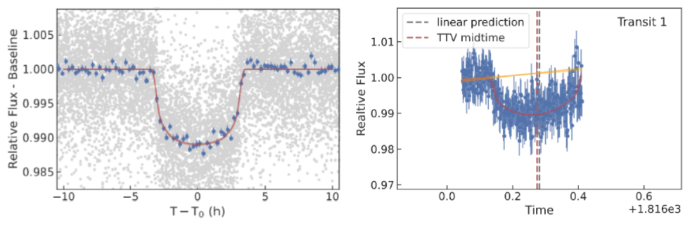Confirmation of the long-period Exoplanet TOI-4409 b
- 1University College London (UCL), Physics and Astronomy, UK
- 2European Space Agency (ESA), European Space Astronomy Centre (ESAC)
- *A full list of authors appears at the end of the abstract
Introduction
The detection and confirmation of long-period transiting planets present significant challenges due to the infrequency of their transits. Such planets are crucial for enhancing our understanding of exoplanet formation and evolutionary dynamics. TOI-4409 b, initially identified by TESS, represents a prototypical case for studying these phenomena.
This study aims to confirm and further characterise TOI-4409 b, a long-period planetary candidate. Utilising a combination of photometric and radial velocity (RV) data, the research focuses on verifying the planet's existence and describing its orbital and physical properties.
Method
The comprehensive analysis incorporated photometric data from TESS, ASTEP, CHAT, and OMES lightcurves, along with RV measurements from HARPS, FEROS, and PFS. In total, the study analysed eight lightcurves from TESS, four from ASTEP, one from CHAT, and three from OMES. RV data spanned from 2018 to 2023, as shown in Figure 1, offering a longitudinal perspective essential for detecting and confirming the planetary signals of TOI-4409 b.
The TESS spacecraft provided the initial detection of TOI-4409 b through its wide-field, high-precision photometry, which is particularly adept at identifying transiting exoplanets. Subsequent observations by the ASTEP telescope, strategically located in Antarctica, leveraged the prolonged periods of darkness and stable atmospheric conditions to observe additional transits. This was critical for capturing the infrequent transits of TOI-4409 b. Lightcurves from CHAT and OMES telescopes further supplemented these observations, enhancing the data's robustness through additional transit captures and minimising gaps in the observational data.
Radial velocity data were obtained using three high-precision spectrometers: HARPS, FEROS, and PFS. These instruments are renowned for their sensitivity in detecting the subtle stellar wobbles induced by orbiting planets, which are crucial for confirming the planetary nature of transit signals. The combined RV dataset enabled a comprehensive analysis of the star's motion, aiding in the verification of TOI-4409 b and suggesting the presence of additional planetary bodies through observed anomalies in the RV signals.
Results
The integrated analysis confirmed TOI-4409 b as an exoplanet with a planetary radius of 7.28±0.20 Earth radii, orbiting a low-mass main sequence star with an effective temperature of approximately 4945±10 K and a stellar radius of 0.720±0.018 solar radii. The orbital period of TOI-4409 b was determined to be 92.4±0.8 days. Two of the processed light curves are shown in Figure 2.
Consistent transit signals across multiple datasets, combined with observed Transit Timing Variations (TTVs), reinforced the candidate’s robustness. These TTVs (showcased in Figure 3), in conjunction with the radial velocity data, suggested the gravitational influence of a second planet in a 20-day orbit around the same star.
The integration of diverse observational methods and data from multiple instruments was pivotal in confirming the planetary status of TOI-4409 b. This approach not only facilitated a thorough characterisation of the planet but also underscored the potential complexities of its orbital dynamics, hinted at by the TTV and RV analyses.
The evidence for a second planet, suggested by anomalies in TTV measurements, points to a potentially rich multi-planetary system, warranting further investigation. This discovery highlights the importance of multi-modal and multi-instrumental data analysis in the field of exoplanet research, where single-method approaches may not suffice due to the complex nature of planetary systems and the limitations of individual observational techniques.
Conclusion
The successful confirmation of TOI-4409 b as a long-period exoplanet and the indication of a secondary nearby planet demonstrates the critical role of global cooperation and technological integration in exoplanetary science. The unique capabilities of the Antarctica-based ASTEP telescope, combined with the extensive data provided by TESS, CHAT, OMES, HARPS, FEROS, and PFS, exemplify how diverse observational assets can come together to enhance our understanding of the universe.
Continued monitoring and future investigations into the TOI-4409 system are essential. They will not only confirm the characteristics and existence of the second suggested planet but will also provide deeper insights into the dynamics and potential habitability of planets in long-period orbits. This study sets a precedent for future research into similar exoplanetary systems, using refined methods and international collaboration to further our understanding of planetary formation and evolution.
Figure 1: All unique photometric observation midtimes, spanning the years 2018 to 2023. This distribution of dates enabled a robust TTV analysis.
Figure 2: TESS (left) lightcurve and ASTEP (right) model fit result, showcasing the transiting nature and the TTV of the signals analysed. All 16 light curves were fitted using the same method.

Figure 3: All the unique transit midtimes of our observations (in BJD - 2458000), alongside their calculated Transit Timing Variations.
Patricio Reller, Rafael Brahm, Bruno Merín, Ingo Waldmann, Trifon Trifonov, Matthew R. Standing, Antónia Vojteková, Maximilian Günter, Tristan Guillot, Keivan G. Stassun, Carlos del Burgo, Ana María Heras, Theresa Lüftinger, Amaury H.M.J. Triaud, Kate Isaak, Georgina Dransfield, Nicolas Crouzet, Anna Francesca Pala, Lyu Abe, Djamel Mékarnia, François-Xavier Schmider, Olga Suarez, Philippe Bendjoya, Abdelkrim Agabi, Domenico Mura, Thomas Gasparetto, Marco Buttu, Jan Eberhardt, Thomas Henning, Melissa J. Hobson, Andrés Jordán, Felipe I. Rojas, Marcelo Tala Pinto, Johanna Teske, R. Paul Butler, Jeffrey D. Crane, Stephen Shectman, Ian Thompson, David Osip, Gavin Boyle, Rodrigo Leiva, Vincent Suc,Gaspar Á. Bakos, W. Bhatti, and Zoltan Csubry
How to cite: Reller, P. and the UCL / ESA / Université Côte d’Azur / Max-Planck-Institut für Astronomie / Millennium Institute for Astrophysics & other groups: Confirmation of the long-period Exoplanet TOI-4409 b, Europlanet Science Congress 2024, Berlin, Germany, 8–13 Sep 2024, EPSC2024-908, https://doi.org/10.5194/epsc2024-908, 2024.